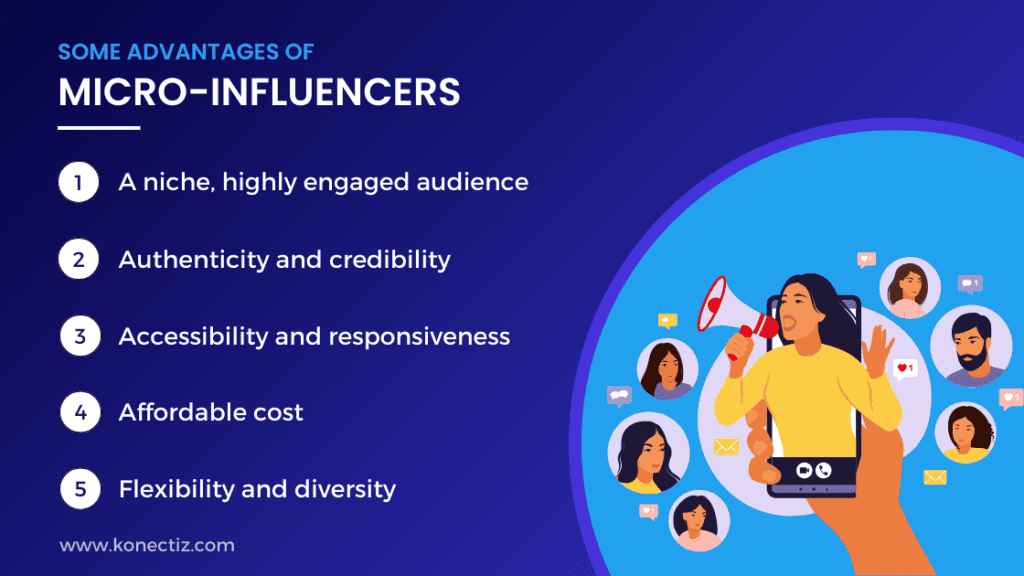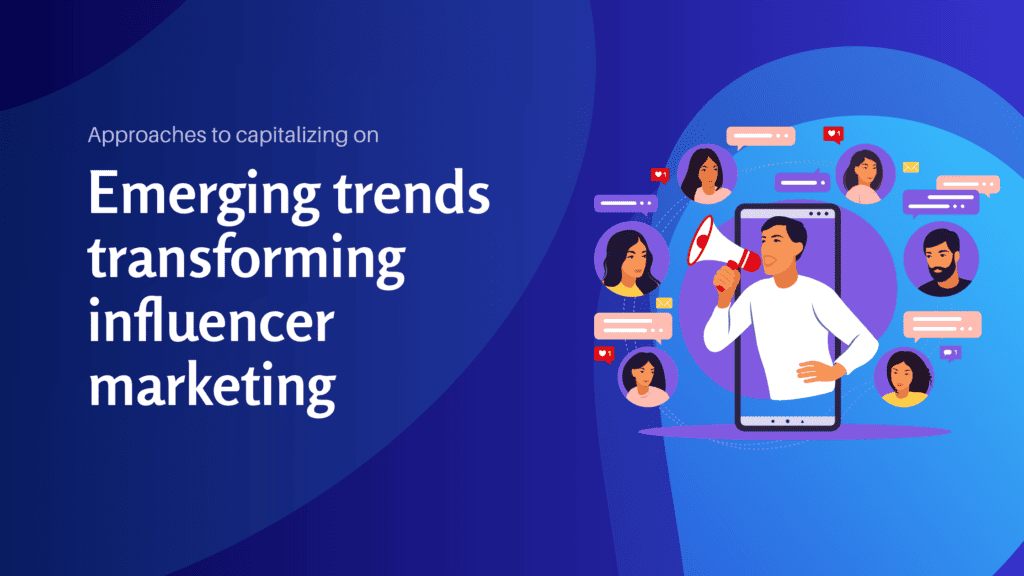Introduction
With the constant evolution of technology and social media, the influencer marketing landscape is constantly changing. New emerging trends are transforming this strategy, bringing incredible opportunities for brands to connect with their target audience in an authentic and engaging way. In this article, we’ll explore these emerging trends that are having a significant impact on influencer marketing.
One of these trends is the rise of micro-influencers. As brands seek to build strong connections with their audiences, they are increasingly turning to content creators with smaller subscriber bases but more engaged and qualified audiences. Micro-influencers offer more targeted reach and higher engagement rates, making them valuable partners for influencer marketing campaigns.
The evolution of influencer marketing
Social media have radically transformed the influencer marketing landscape. Platforms such as Instagram, YouTube and TikTok have given influencers the ability to reach millions of people with their content. What’s more, consumers are spending more and more time on these platforms, making them essential marketing channels for brands.
One of the main reasons for the effectiveness of social media in influencer marketing is their ability to establish authentic connections between influencers and their audience. Influencers regularly share their daily lives, opinions and experiences with their followers, creating a bond of trust and authenticity. This relationship of trust enables brands to partner with influencers who reflect their values and brand identity, reinforcing their credibility and visibility in the marketplace.
New trends in influencer marketing
Influencer marketing is constantly evolving to adapt to changes in the digital landscape and consumer preferences. Emerging trends include a diversification of the platforms used by influencers. While traditional social networks like Instagram and YouTube remain popular, new emerging platforms like TikTok and Twitch are gaining traction in influencer marketing. Brands are looking to explore these new platforms to reach specific, diversified audiences. Another emerging trend is the emphasis on transparency and authenticity.
Consumers are increasingly aware of the partnerships between influencers and brands, and demand full transparency on the nature of these collaborations. In response to this growing demand, influencers and brands are looking to establish more authentic partnerships and share content that truly reflects their values and beliefs.
Finally, influencer marketing is becoming increasingly focused on micro-influencers and long-term collaborations. Rather than focusing solely on influencers with large numbers of followers, brands are recognizing the value of micro-influencers, who often have more engaged and niche audiences. What’s more, long-term collaborations with influencers enable brands to develop stronger, longer-lasting relationships with their target audiences, which can lead to greater brand loyalty and more sustainable business results.
Micro-influencers and their role in influencer marketing
User-generated content has become a key element of influencer marketing. Consumers increasingly trust peer recommendations rather than traditional advertising. User-generated content, whether product reviews, photos or videos, offers social proof of a product or brand’s authenticity. The Yotpo tool encourages the creation of user-generated content, including reviews and images, to reinforce brand influence.
Brands can capitalize on this trend by encouraging their customers to create user-generated content. This can be done through contests, specific hashtags or referral programs. By sharing this content on their own platforms, brands can reinforce their credibility and connection with their audience.
Micro-influencers have become key players in the influencer marketing landscape. These content creators, often followed by a few thousand to tens of thousands of subscribers, have a significant impact on their niche, highly engaged audience. Their influence stems from their ability to cultivate authentic relationships with their audience, sharing relevant, authentic content that resonates with their followers.
What distinguishes micro-influencers from the big names in influence is their ability to create a close, personal bond with their community. Their audience often sees them as peers or friends, making their recommendation of products or services more credible and convincing. What’s more, micro-influencers tend to be more accessible and responsive to interactions with their subscribers, further strengthening the trust and loyalty of their audience.
Some advantages of micro-influencers

1. A niche, highly engaged audience
Micro-influencers generally have a very specific, engaged audience, enabling brands to target precise market segments and achieve a higher return on investment.
2. Authenticity and credibility
Because of their smaller audience size, micro-influencers are perceived as more authentic and credible by their audience. Their product or service recommendations are therefore more likely to be taken into account.
3. Accessibility and responsiveness
Micro-influencers are often more accessible and responsive to interactions with their audience, strengthening the bonds of trust and loyalty with their community.
4. Affordable cost
Collaborations with micro-influencers are generally more affordable than those with macro-influencers, enabling brands to carry out influencer marketing campaigns even with limited budgets.
5. Flexibility and diversity
By working with several micro-influencers, brands can diversify their influencer marketing strategy and reach different segments of their target audience, while maintaining an authentic, personalized approach.
User-generated content and its influence on influencer marketing
User-generated content (UGC) plays an increasingly important role in influencer marketing. This form of content, created and shared by users themselves, has many advantages for brands looking to strengthen their online presence and engage their audience in an authentic way.
First and foremost, UGC offers unrivalled authenticity. Since the content is created by the users themselves, it is perceived as more authentic and credible by other members of the community. Consumers tend to trust peer recommendations and testimonials more than brand-sponsored content. Taggbox A tool that aggregates user-generated content across different platforms, enabling brands to showcase content from their followers.
Secondly, UGC enables brands to extend their organic reach. When users share self-generated content on their own social networks or online platforms, this enables the brand to reach new audiences without having to invest heavily in advertising campaigns. What’s more, it creates a virtual word-of-mouth effect, where users actively recommend the brand’s products or services to their personal network.
The rise of video content in influencer marketing
In the dynamic landscape of influencer marketing, authenticity and transparency have become non-negotiable values. Increasingly savvy consumers are looking for partnerships between brands and influencers that are authentic and aligned with their own values. Brands must therefore ensure that their collaborations with influencers are sincere and transparent.
It’s essential for brands to be transparent about their partnerships with influencers. Consumers are increasingly aware of influencer marketing practices, and are attentive to paid partnerships and sponsored recommendations. It is therefore vital that brands clearly disclose paid partnerships and ensure that recommendations made by influencers are based on real experiences with products.
By guaranteeing authenticity and transparency in their partnerships with influencers, brands reinforce their brand’s trust and credibility with consumers. These practices foster lasting, meaningful relationships with the public, and help consolidate the brand’s reputation over the long term. Ultimately, authenticity and transparency are the cornerstones of any successful influencer marketing partnership.
Authenticity and transparency in influencer marketing
The future of influencer marketing is bright, and technological advances will continue to shape the practice and open up new perspectives for brands. Advances in virtual and augmented reality offer brands even more creative ways to engage with their audiences, creating immersive and memorable experiences.
What’s more, the rise of social media and live streaming platforms is opening up new possibilities for influencer marketing. Brands can now collaborate with influencers to organize live events, live broadcasts or Q&A sessions. These live interactions create a unique closeness and authenticity, strengthening the bond between the brand and its audience. Authenticity and transparency will remain at the heart of influencer marketing.
Consumers are increasingly demanding authentic, heartfelt content, and brands that embrace these values will be better positioned to succeed in the competitive influencer marketing landscape. By cultivating authentic relationships with influencers and ensuring that their partnerships are transparent, brands can build trust and loyalty with their audiences, and thus ensure their long-term success in influencer marketing.
The future of influencer marketing
Influencer marketing is evolving at a breakneck pace, opening up exciting new opportunities for brands. Among the emerging trends transforming this strategy, micro-influencers and the use of virtual and augmented reality stand out as driving forces for change.
For brands, staying on top of these trends is essential to maximize the effectiveness of their influencer marketing campaigns. By partnering with micro-influencers, brands can reach more targeted and engaged audience segments, benefiting from a more authentic influence and a more significant impact. Similarly, the integration of virtual and augmented reality offers brands the opportunity to create immersive and memorable experiences, strengthening their connection with their audience.
Conclusion
The art of creating compelling content for entrepreneurs is a subtle blend of strategy, creativity and engagement. Throughout this article, we’ve explored the essential foundations of content marketing, diving into the power of blogging, the art of storytelling, maximizing engagement, and the importance of analyzing results.





